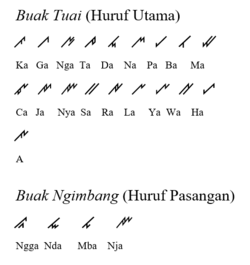Rejang alphabet
| Rejang ꥆꤰ꥓ꤼꤽ ꤽꥍꤺꥏ | |
|---|---|
 | |
| Script type | Abugida |
Time period | ?–present |
| Direction | Left-to-right |
| Languages | Malay, Bengkulu, Rejang |
| Related scripts | |
Parent systems | Proto-Sinaitic alphabet[a]
|
Sister systems | Kerinci, Lembak, Serawai, Pasemah, Lampung alphabet |
| ISO 15924 | |
| ISO 15924 | Rjng (363), Rejang (Redjang, Kaganga) |
| Unicode | |
Unicode alias | Rejang |
Unicode range | U+A930–U+A95F |
[a] The Semitic origin of the Brahmic scripts is not universally agreed upon. | |
| This article contains phonetic transcriptions in the International Phonetic Alphabet (IPA). For an introductory guide on IPA symbols, see Help:IPA. For the distinction between [ ], / / and ⟨ ⟩, see IPA § Brackets and transcription delimiters. | |
| Brahmic scripts |
|---|
| The Brahmi script and its descendants |
| Southern Brahmic |
|
The Rejang script is an abugida of the Brahmic family that is related to other scripts of the region, such as the Batak and Lontara scripts. Rejang is also a member of the closely related group of Ulu scripts that include the script variants of South Sumatra, Bengkulu, Lembak, Lintang, Lebong, and Serawai. Other closely related scripts that are sometimes included in the Surat Ulu group include the Ogan, Kerinci, and Lampung scripts. The script was in use prior to the introduction of Islam to the Rejang area; the earliest attested document appears to date from the mid-18th century CE. The Rejang script is sometimes also known as the KaGaNga script following the first three letters of the alphabet. The term KaGaNga was never used by the users of the script community, but it was coined by the British anthropologist Mervyn A. Jaspan (1926–1975) in his book Folk literature of South Sumatra. Redjang Ka-Ga-Nga texts. Canberra, The Australian National University 1964.
The script was used to write texts in Malay and Rejang, which is now spoken by about 200,000 people living in Indonesia on the island of Sumatra in the southwest highlands, north Bengkulu Province, around Arga Makmur, Muaraaman, Curup, and Kepahiang, and also in the Rawas area of South Sumatra Province, near Muara Kulam. There are five major dialects of Rejang: Lebong, Musi, Kebanagung, Pesisir (all in Bengkulu Province), and Rawas (in South Sumatra Province). Most of its users live in fairly remote rural areas, of whom slightly less than half are literate.
The traditional Rejang corpus consists chiefly of ritual texts, medical incantations, and poetry.
Letters
Letters of the script can be found in the inscription below:[1][2]

Letters with IPA
The script's diacritics are attached here to the base letter a (ꥆ) to disambiguate similar ones if the base letter isn't used, like in the case with /i/, /u/, /əu̯/, and /ɛa̯/. Exception for the virama, in which its base letter is ka (ꤰ).
| Rejang alphabet with pronunciation in IPA[3] | ||||||||||||||||
| Rejang | ꤰ | ꤱ | ꤲ | ꤳ | ꤴ | ꤵ | ꤶ | ꤷ | ꤸ | ꤹ | ꤺ | ꤻ | ꤼ | ꤽ | ꤾ | ꤿ |
| IPA | [k] | [ɡ] | [ŋ] | [t] | [d] | [n] | [p] | [b] | [m] | [c] | [ɟ] | [ɲ] | [s] | [r] | [l] | [j] |
| Rejang | ꥀ | ꥁ | ꥂ | ꥃ | ꥄ | ꥅ | ꥆ | ꥆꥇ | ꥆꥈ | ꥆꥉ | ꥆꥊ | ꥆꥋ | ꥆꥌ | ꥆꥍ | ꥆꥎ | ꥆꥏ |
| IPA | [w] | [h] | [mb] | [ŋg] | [nd] | [ɲɟ] | [a], [ə] | [i], [ɪ] | [u], [ʊ] | [ɛ], [e] | [ai̯] | [o], [ɔ] | [au̯] | [əu̯] | [ɛa̯] | final [ŋ] |
| Rejang | ꥆꥐ | ꥆꥑ | ꥆꥒ | ꤰ꥓ | ||||||||||||
| IPA | final [n] | final [r] | final [ʔ] | (no vowel) | ||||||||||||
See also
References
External links
- https://www.unicode.org/L2/L2021/21116-surat-ulu.pdf











